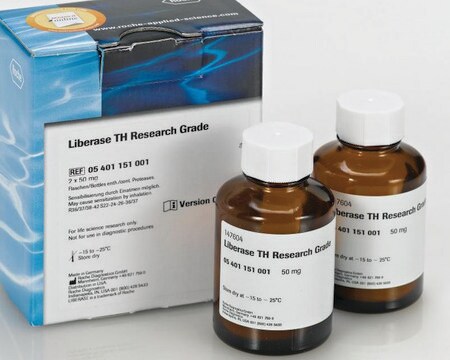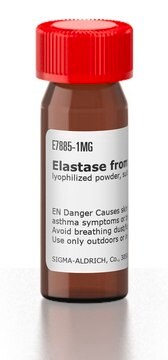LIBTM-RO
Roche
Liberase™ TM Research Grade
medium Thermolysin concentration
About This Item
Recommended Products
Quality Level
form
lyophilized
packaging
pkg of 10 mg (05401119001 [2 x 5 mg])
pkg of 100 mg (05401127001 [2 x 50 mg])
manufacturer/tradename
Roche
parameter
35-37 °C optimum reaction temp.
technique(s)
single cell analysis: suitable
tissue processing: suitable
color
white
optimum pH
7.4
solubility
water: soluble
suitability
suitable for flow cytometry
application(s)
life science and biopharma
sample preparation
foreign activity
Endotoxin 1 EU/mg
shipped in
dry ice
storage temp.
−20°C
General description
Application
Features and Benefits
- Maximize viability and yield of isolated cells: with an enzyme blend that has less clostripain and trypsin activity, as well as reduced endotoxin content.
- Count on higher specific activity of the enzyme blend: as a result of higher Collagenase I + II purity (determined by HPLC analysis).
- Obtain higher experimental reproducibility: due to higher lot-to-lot consistency.
- Increase safety: with an enzyme that is free of any mammalian or avian tissue-derived raw materials.
Preparation Note
Working concentration: Liberase Research Grade Enzyme Working Concentration
Liberase enzymes have significantly higher specific activities than traditional collagenases. This means that the working concentration of Liberase Research Grade Purified Enzymes, expressed in mg/ml, will be lower than that of traditional collagenase.
When the application is not included on this list, first use Liberase TM Research Grade at a concentration of 0.08–0.28 Wünsch units/ml.The goal is to determine the best starting concentration of Liberase Research Grade Enzyme Blends. This is a starting point, and the final concentration may vary due to differences in procedure and lot-to-lot differences in traditional collagenase.
Collagenase Working Concentration
Multiply your previous collagenase working concentration (mg/ml) by its specific activity (Wünsch units/mg, [as determined above]), to obtain Wünsch units/ml. To determine how much Liberase Research Grade Enzyme Blend to use, first multiply your collagenase working concentration (in Wünsch units/ml) times the total volume of your working enzyme solution to obtain the total collagenase activity needed (Wünsch units). Divide the total collagenase activity required by the Liberase Research Grade stock concentration ( “Reconstitution and Storage”). This indicates how many milliliters of Liberase Research Grade Enzyme Blend stock solution to use in your working enzyme solution.
Storage conditions (working solution): Store unused stock solution in single-use aliquots at -15 to -25 °C.
Note: Avoid repeated freezing and thawing!
Reconstitution
Reconstitute the entire vial. Do not weigh individual aliquots of the lyophilizate. The introduction of moisture into the vial results in a decline in enzymatic activity.
Place vial on ice to rehydrate the lyophilized enzyme.
Gently agitate the vial at 2 to 8 °C until enzyme is completely dissolved (max. 30 min).
Depending on the type of tissue-dissociation buffer used to dissolve Liberase Research Grade Purified Enzyme Blends, slight precipitations may be observed which readily dissolve in the dilutedworking solution, and have no influence on enzyme activity.
Remove an aliquot of the stock solution to prepare the working solution.
Reconstitution volume
2 ml (1 vial with 5 mg–10 mg pack size), 10 ml (1 vial with 50 mg–100 mg pack size)
Collagenase Wünsch (units/ml)
13 (1 vial with 5 mg–10 mg pack size), 26 (1 vial with 50 mg–100 mg pack size)
Total Collagenase concentration [mg/ml]
2.5 (1 vial with 5 mg–10 mg pack size), 5.0 (1 vial with 50 mg–100 mg pack size)
Storage and Stability
Other Notes
Legal Information
also commonly purchased with this product
Signal Word
Danger
Hazard Statements
Precautionary Statements
Hazard Classifications
Eye Irrit. 2 - Resp. Sens. 1 - Skin Irrit. 2 - STOT SE 3
Target Organs
Respiratory system
Storage Class Code
11 - Combustible Solids
WGK
WGK 1
Flash Point(F)
does not flash
Flash Point(C)
does not flash
Certificates of Analysis (COA)
Search for Certificates of Analysis (COA) by entering the products Lot/Batch Number. Lot and Batch Numbers can be found on a product’s label following the words ‘Lot’ or ‘Batch’.
Already Own This Product?
Find documentation for the products that you have recently purchased in the Document Library.
Customers Also Viewed
Articles
Enzyme Explorer Key Resource: Collagenase Guide.Collagenases, enzymes that break down the native collagen that holds animal tissues together, are made by a variety of microorganisms and by many different animal cells.
Protocols
Liberase™ TM Research Grade Protocol & Troubleshooting
Our team of scientists has experience in all areas of research including Life Science, Material Science, Chemical Synthesis, Chromatography, Analytical and many others.
Contact Technical Service














